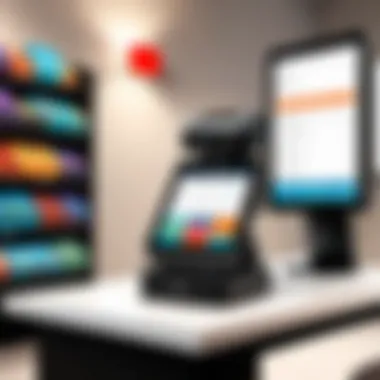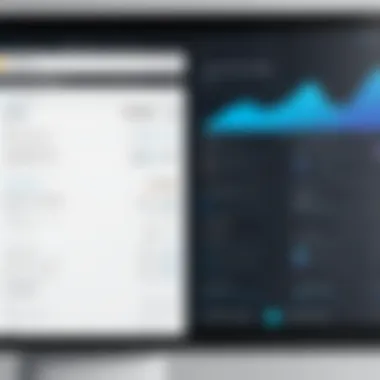Revel POS Pricing: A Comprehensive Analysis for Businesses


Intro
In the ever-evolving landscape of payment solutions, choosing the right point-of-sale (POS) system is critical for businesses. Revel POS stands out as a notable player in this domain, offering a versatile POS solution tailored for various sectors. Understanding its pricing structure is crucial for businesses considering adoption. By dissecting this pricing model, we can unveil its cost components, including software subscriptions, hardware expenses, and ongoing service charges. This analysis not only delineates the overall expense but also assesses the relevance of its offerings for different business sizes, from nimble startups to expansive corporate entities.
Key Features
Overview of Features
Revel POS provides a robust feature set designed to streamline operations. It encompasses inventory management, employee scheduling, and customer relationship tools. These capabilities allow businesses to optimize their workflows and enhance customer experiences. Additionally, Revel offers detailed reporting and analytics that enable informed decision-making, a critical aspect for growth-oriented companies.
Unique Selling Points
One distinguishing factor that elevates Revel POS above competitors is its cloud-based functionality. This ensures real-time data accessibility from any location, which is vital for business owners on the move. Furthermore, Revel's integration with various payment processors adds flexibility, catering to diverse business models. Its user-friendly interface is another key advantage, minimizing the learning curve for staff, thus allowing firms to implement the system seamlessly.
Pricing Structure
Tiered Pricing Plans
Revel POS adopts a tiered pricing model, catering to different business demands. The plans typically range from basic to enterprise levels, allowing users to choose a plan that aligns with their operational complexity. While exact pricing can fluctuate based on specific business needs and settings, the tiers are generally structured to provide scalable features across plans.
Features by Plan
The distinction in features across pricing tiers is significant.
- Basic Plan:
- Advanced Plan:
- Enterprise Plan:
- Core POS functionalities
- Basic inventory management
- Limited reporting capabilities
- All features from Basic
- Enhanced analytics
- Advanced customer relationship tools
- All features from Advanced
- Customized solutions
- Premium 24/7 support
Such differentiation ensures that businesses can select a plan that meets their current needs while keeping scalability in mind for the future. Understanding how each plan aligns with business goals is essential for making an informed decision.
"An investment in the right POS system can significantly affect a business's operational efficiency and customer satisfaction."
In comparison to similar market alternatives, Revel POS reflects a competitive pricing structure with valuable features worth considering. As we delve deeper into specific costs associated with hardware and service maintenance, this exploration will equip businesses with a nuanced understanding required for effective decision-making.
Overview of Revel POS
Understanding the landscape of Revel POS is essential for any business considering its implementation. The Revel POS system is not just a point-of-sale. It encapsulates a suite of tools designed to streamline transactions, manage inventory, and analyze sales data. Appreciating the core elements of Revel POS helps illuminate its value and significance in various sectors. This section lays the groundwork for deeper insights into its pricing, features, and benefits.
Prolusion to Revel Systems
Revel Systems emerged as a significant player in the point of sale industry. Founded in 2010, it was created to address the evolving needs of businesses seeking efficiency in operations. Revel integrates both hardware and software seamlessly, presenting a unified platform. This approach allows businesses to manage operations from a single interface, which is a compelling asset in a competitive market.
Business owners often look for solutions that not only simplify sales transactions but also enhance customer experiences. Revel’s cloud-based technology facilitates access to real-time data. This capability is crucial for making informed decisions swiftly, especially in dynamic environments like retail and hospitality.
Key Features of Revel POS
Revel POS stands out for its robust set of features that cater to diverse business requirements. Here are some essential characteristics:
- Customizable Interface: Users can tailor their layout to ensure efficiency in operation.
- Inventory Management: This functionality allows real-time tracking, helping businesses maintain optimal stock levels.
- Reporting and Analytics: Revel provides in-depth analytics tools. Businesses can analyze sales trends and customer behavior, which aids in strategic planning.
- Employee Management: Employee schedules and performance analytics are integrated, making it easy to oversee staff effectively.
These features reflect a commitment to enhancing operational efficiency. Businesses can leverage these tools to fine-tune their strategies and ensure customer satisfaction.


Target Markets for Revel POS
Revel POS is tailored for various industries, making it versatile. Its main target markets include:
- Restaurants: Features like order management and table tracking cater specifically to food service environments.
- Retail: The system’s inventory management and reporting capabilities are ideal for retailers who require detailed insights into their stock.
- Food Trucks and Catering Services: The mobile capabilities allow food services to operate flexibly in different settings.
- Entertainment Venues: Revel can handle ticket sales and merchandise transactions effectively in venues like theaters and amusement parks.
This diverse applicability ensures that businesses across sectors can find valuable use cases for adopting Revel POS. By understanding these target markets, potential users can evaluate how Revel POS aligns with their specific needs.
Understanding POS Pricing Models
Understanding the various POS pricing models is crucial for businesses evaluating different solutions, including Revel POS. The payment systems landscape anticipates diverse pricing structures tailored to fit varied operational needs. Thus, a clear grasp of these models can lead to informed decision-making when investing in a POS system.
The relevance of understanding POS pricing extends beyond mere numbers; it connects to the broader business strategy. Companies need to align their POS system investments with their short and long-term goals. This section examines key pricing models and the elements influencing them, providing insights for decision-makers.
Types of Pricing Models
There are different pricing models for POS solutions, each designed to cater to unique business circumstances. Some of the most common types include:
- Flat-rate pricing: This model involves a consistent fee for services rendered, regardless of transaction volume. It is straightforward and predictable, useful for companies with stable sales patterns.
- Tiered pricing: This model offers different rates based on transaction volumes. As sales increase, businesses can benefit from lower rates in higher tiers. It's advantageous for scaling operations.
- Interchange-plus pricing: In this model, the merchant pays a variable fee based on the actual costs of payment processing plus a small markup. While it can be more complex, it often offers transparency regarding transaction costs.
- Subscription-based pricing: Companies pay a recurring fee for access to POS software and services. This model is prevalent among cloud-based solutions and allows for easy budgeting.
Each model has its pros and cons, and selecting the correct one impacts the bottom line significantly.
Factors Influencing Pricing
Several factors dictate the pricing structure of POS systems, including Revel POS. It is essential for business owners to consider these elements when analyzing potential costs:
- Transaction volume: Higher sales may lead to different pricing tiers. Thus, the more a business sells, the more likely it can realize savings.
- Business size: Small businesses often face different pricing concerns than larger enterprises. Larger operations might negotiate better rates due to volume leverage.
- Service package: Not all POS systems come with the same features or support levels. The inclusion of analytics, inventory management, and customer support affects pricing.
- Industry: Certain sectors may require specific adaptations, impacting pricing. For instance, restaurant POS systems may include additional functionalities compared to retail systems.
- Contract length: The duration of the agreement can influence pricing. Longer contracts might yield lower monthly fees, but they also require a more significant commitment.
Understanding these factors helps businesses paint a clearer picture of their total costs, leading to more effective budgeting and forecasting.
"Choosing a suitable POS model is essential not only for current operations but also for future growth and flexibility."
Detailed Breakdown of Revel POS Pricing
Understanding the detailed breakdown of Revel POS pricing is essential for businesses considering this point-of-sale system. This section delves into various cost components that accumulate to form the total expenditure, helping businesses plan their budgets efficiently. By examining each element closely, prospective buyers can identify which costs are necessary and which can be optimized. This analysis aids in assessing the overall value derived from investing in Revel POS compared to competitors.
Software Subscription Fees
Monthly vs. Annual Billing
Monthly vs. annual billing is a significant aspect of software subscription fees. Many businesses face the decision of how to structure their payments. Monthly billing can be appealing due to its flexibility, allowing companies to conserve cash flow and adapt quickly to changing needs. However, annual billing often provides cost savings over time. Its upfront payment secures a lower rate, making it a popular choice for those committed to long-term use of the software.
A unique feature of annual billing is the potential for discounts which companies often receive for committing to a longer contract. However, businesses must balance the advantage of savings against the risk of being locked into a service they may later wish to reevaluate.
Included Features and Services
The included features and services of Revel POS also merit careful consideration. Each subscription typically encompasses core functionalities that support business operations. This may include transaction processing, inventory management, and reporting tools.
One key characteristic is that higher tiers of service may unlock more advanced features. These can be complementary for larger businesses that require sophisticated analytics or specialized tools. However, small businesses should be cautious; they may not need all available features, potentially leading to an unnecessary expenditure.
Hardware Costs
Essential Hardware Components
Essential hardware components represent a fundamental aspect of Revel POS's pricing structure. This typically includes devices such as tablet stands, cash drawers, receipt printers, and barcode scanners. These hardware components are vital to ensure seamless operations in any retail or food service environment.


The advantage of opting for Revel's recommended hardware is compatibility and enhanced performance. However, upfront costs can be a burden, especially for startups. Assessing whether these essential tools are imperative for immediate operation is critical.
Optional Add-Ons and Upgrades
Optional add-ons and upgrades allow businesses to customize their Revel POS setup. Features such as additional terminals, advanced reporting solutions, or specialized hardware can be added as needed. This flexibility means businesses can expand their POS capabilities without the need for a significant outlay from the start.
This can be particularly beneficial for companies anticipating growth. However, reliance on optional updates may lead to escalating costs, so careful budgeting and planning are advisable.
Payment Processing Fees
Transaction Fees
Transaction fees are another component in the pricing structure that needs scrutiny. These fees often apply to each transaction processed through the Revel POS system, frequently expressed as a percentage or a flat rate.
One key characteristic of transaction fees is that they can vary significantly based on the type of transaction (e.g., credit card vs. debit card). Many businesses find that negotiating lower rates is possible, but that depends on sales volume and performance. Understanding these fees is crucial to accurately estimating total costs over time.
Hidden Costs to Consider
Looking for hidden costs is vital when evaluating any POS system, including Revel. Some fees may not be immediately apparent, like chargeback fees or fees associated with specific payment types.
Often, businesses overlook these costs until they start impacting profitability. It's essential to thoroughly review contracts and understand all potential charges to have a full picture of the financial landscape.
Installation and Setup Fees
Installation and setup fees are another often overlooked cost associated with adopting new POS systems. These fees can encompass the physical installation of hardware as well as software configuration.
Investing in professional installation ensures a system gets up and running without hassle, particularly when integrating complex software. Thus, while these fees add to initial costs, they can save time and reduce potential frustrations in the long run.
Ongoing Support and Maintenance Costs
Ongoing support and maintenance costs are a critical aspect of the total cost of ownership for Revel POS. While the initial pricing may look reasonable, businesses must factor in the expense of continuous support. This can include software updates, technical assistance, and system optimization.
Having support available can significantly impact operational efficiency. However, if these services are billed separately, they may lead to higher costs, requiring careful evaluation during the purchasing decision.
Evaluating the Value of Revel POS Pricing
Analyzing the effectiveness of Revel POS pricing takes into account multiple factors. Understanding the overall cost versus the benefits offered by Revel's system is crucial for potential buyers. Organizations must assess whether the pricing model aligns with their operational needs and business objectives. This section aims to elucidate the rationale behind the pricing structure and the long-term value it offers.
Cost vs. Benefits Analysis
The cost versus benefits analysis of Revel POS is paramount for businesses seeking a reliable POS system. A thorough evaluation involves not only the immediate outlay but also the recurring expenses associated with the software and hardware. Here are some pivotal points to consider:
- Initial Setup Costs: Revel POS entails specific expenses like installation and training. Effective budgeting ensures that users do not experience sudden spikes in expenditures.
- Ongoing Fees: Consider monthly subscription costs. Are these fees justified by the value that the system delivers? Finding the right balance is key for sustainability.
- Feature Accessibility: Revel POS is known for a rich set of functionalities. Efficient inventory management, robust reporting features, and customer relationship management tools can lead to enhanced decision-making.
- Return on Investment: Analyzing potential gains can provide clarity on whether the pricing is worth the initial investment. Immediate benefits, as well as longer-term value, must both be evaluated. For example, improved sales tracking can lead to better revenue management over time.
"Investing in a quality POS system like Revel can streamline operations, which may justify the cost in the long run."
Scalability and Business Growth
Scalability is an essential factor when evaluating any system, especially for businesses poised for growth. Revel POS offers flexible solutions that can adapt as a business expands. Here’s why its scalability is a prime consideration:
- Growth Support: As businesses grow, their needs change. Revel provides features that can easily be upgraded or expanded, making it suitable for both small establishments and large enterprises.
- Customizable Packages: Companies can choose specific modules to add based on current requirements, avoiding unnecessary costs while allowing room for future expansion.
- Multi-Location Functionality: For businesses with multiple outlets, Revel POS can be synchronized across various locations. Managing diverse setups becomes more efficient when a single POS solution caters to all.
- Long-Term Partnerships: By selecting a robust system like Revel, businesses forge a partnership that can evolve alongside their growth trajectory. The nimbleness of Revel ensures that organizations are not locked into outdated features or paying for excess capabilities that they do not need.
Understanding the value of Revel POS pricing, therefore, involves not just evaluating the current expenditure but also foresight into future requirements. Businesses require tools that not only address present-day needs but also scale with their ambitions.
Comparative Analysis with Competitors


In understanding the Revel POS pricing structure in depth, contrasting it with other point-of-sale solutions is essential. A comparative analysis allows businesses to see how Revel compares in terms of cost, functionality, and customer support. This not only aids in informed decision-making but also highlights gaps that might be exploited by competitors. It is crucial for potential users to assess whether Revel POS meets their unique needs against available alternatives.
Revel POS vs. Other POS Solutions
Revel POS operates in a competitive landscape populated by various POS providers, each boasting unique features and pricing models. Key competitors include Square, Shopify, and Lightspeed. When comparing Revel with these solutions, some specific elements should be analyzed:
- Cost: The pricing structures vary widely among competitors. Revel offers a more comprehensive suite of features, which might come at a higher base price compared to simpler solutions like Square.
- Features: Revel provides advanced features tailored for larger businesses, such as inventory management and analytics. In contrast, solutions like Shopify may cater more to e-commerce-focused operations.
- Usability: User experience can vastly differ. Revel's interface is designed for complex operations, whereas other systems might prioritize simplicity for quick transactions.
- Customer Support: Assessing the availability and responsiveness of customer support is vital. Revel is known for solid support options but might not be available 24/7 like some other services.
Understanding these differences can better inform businesses about which POS solution best aligns with their operational requirements and budgetary constraints.
Strengths and Weaknesses of Rival Pricing Models
Every POS system has its strengths and weaknesses, particularly tied to their pricing models.
Strengths of Competing Models
- Flexibility: Some competitors offer pay-as-you-go options that allow businesses to scale up or down depending on their needs.
- Lower Entry Costs: Solutions like Square have no monthly fee, making them attractive for startups or small businesses with limited budgets.
- User-Friendly Interfaces: Many alternative systems prioritize a seamless user experience, which can reduce training time for staff.
Weaknesses of Competing Models
- Limited Features: Simpler pricing models often correlate to fewer features, which might inhibit growth for rapidly expanding businesses. For instance, while Square is cost-effective, it lacks some of the advanced inventory or analytics tools that Revel provides.
- Higher Transaction Fees: Some models have higher per-transaction costs that can accumulate significantly over time, negating any initial savings from a lower subscription rate.
- Scalability Issues: As businesses grow, they might find that some POS systems do not cater to high-volume transactions or complex operations, leading to needing a costly platform switch in the future.
Understanding the strengths and weaknesses of various POS pricing models helps ensure that businesses choose a solution that supports their long-term objectives while being cost-effective.
Customer Feedback and Satisfaction
Understanding customer feedback and satisfaction is crucial when evaluating Revel POS pricing. Listening to users provides insights that can shape the perception of the product's value. Customer reviews can highlight both strengths and areas for improvement, allowing potential buyers to make informed decisions based on real-world experiences. In a market where choices are abundant, users’ opinions can clarify what to expect regarding pricing and the corresponding value received.
Insights from Users
The insights gleaned from users of Revel POS offer a nuanced picture of its effectiveness. Many users praise the intuitive interface and robust features that cater to diverse business requirements. For example, one restaurant owner noted how the customization options suited their culinary needs precisely, helping them manage orders more efficiently. On platforms like Reddit and Facebook, reviews often reflect satisfaction over the integration of payment processing.
Furthermore, businesses highlight the adaptability of Revel POS across varying sectors, from retail to hospitality. They often emphasize how its capabilities enhance operational workflows, reducing time spent on manual processes. However, it's essential to take into account not only positive feedback. Some users report challenges with customer service response times and the complexity of specific software updates. Such feedback can guide potential buyers to understand the average experience they might encounter.
Common Concerns Related to Pricing
While Revel POS has its supporters, there are common pricing concerns voiced by users. One significant issue relates to the initial cost of hardware and software setups. Many users express that the upfront investment can be daunting for small businesses. What’s more, transaction fees associated with payment processing sometimes lead to unexpected costs. Users pointed out that these additional expenses can accumulate over time, making it imperative to analyze the long-term financial implications before deciding.
Another frequent concern is the subscription model, which can feel less transparent. Clients often wonder what is included in the monthly fees versus what constitutes extra costs. This lack of clarity can create hesitation and doubt about the overall value.
For businesses in tight financial conditions, understanding these factors is vital. Clarity in pricing models can alleviate some concerns, but thorough research and feedback analysis remain necessary to ensure an informed purchasing choice.
Epilogue
The conclusion serves as a pivotal element in this exploration of Revel POS pricing. It synthesizes the essential insights outlined throughout the article, ensuring that readers grasp the crux of the information shared.
Recap of Revel POS Pricing
Revel POS offers a multifaceted pricing structure that reflects its position as a leading point-of-sale system. The pricing encompasses several critical components including software subscription fees, hardware costs, and ongoing service charges. Assuming the role of a considerable investment in enhancing operational efficiency, business owners must evaluate all aspects of the cost. Given that pricing can vary significantly based on the size and complexity of the business, understanding each component is vital.
Some key points to recall include:
- Software Subscription Fees: Varying plans depending on business size and needs.
- Hardware Costs: Mandatory equipment versus optional upgrades.
- Payment Processing Fees: Includes both visible transaction fees and potential hidden charges.
- Installation and Setup Fees: Considered as part of the total initial investment.
This overview helps potential users understand what they pay for when opting for Revel POS.
Final Thoughts on Efficiency and Cost-Effectiveness
Investing in Revel POS is often viewed through the lens of its efficiency and cost-effectiveness. The direct correlation between the costs incurred and the potential savings generated underscores the significance of this choice in a competitive marketplace. For many businesses, the benefits of centralized operations and improved customer service capabilities justify the investment in Revel POS.
Additionally, factors that improve business processes—like streamlined transaction processes and better inventory management—ultimately contribute to a more cost-effective operation. Decision-makers should consider how these efficiencies align with their own business model and if the investment will provide adequate returns.















